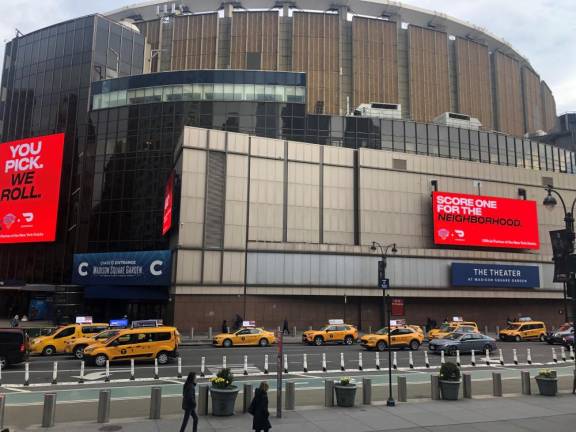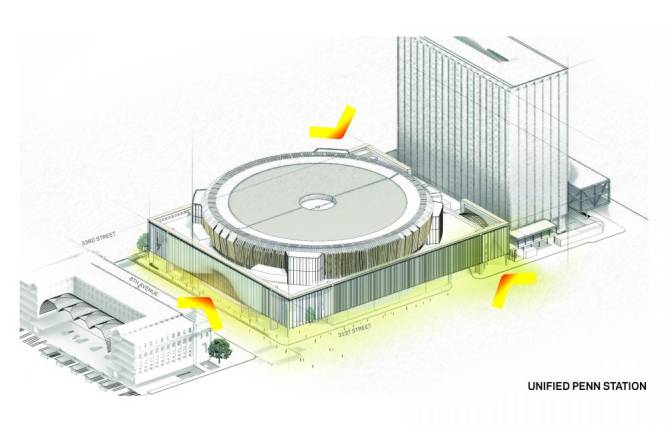We Are Now the “Only Plan Left Standing,” Says Italian Developer in Wake of City Council Vote on Madison Square Garden
Following a vote by the land use committee of the City Council to renew Madison Square Garden’s permit to operate its 20,000 arena above Penn Station for only five more years, developer ASTM now says it is the only viable option to rebuild the rail hub.
The Italian infrastructure company that wants to rebuild Penn Station says its plan is now the only path forward after the City Council decided to keep Madison Square Garden on a short leash but declined at the same time to force it to turn over property for a renovation, as the MTA has been demanding.
“We are the only plan left standing,” said Vishaan Chakrabarti, principle architect for the Penn Station plan offered by ASTM, an Italian based private equity and Infrastructure development company.
Chakrabarti and his colleague Peter Cipriano, senior vice president of ASTM North America, said they had a fully negotiated agreement with Madison Square Garden to purchase the needed property.
They said this would allow them to move more quickly than anyone else to completed designs. Their renovation of the station could be completed by 2031, they said.
The ASTM officials spoke at an online news briefing less than 24 hours after two City Council committees acted to limit to five years the new special permit the Garden needs to operate its 20,000 seat arena. The previous ten-year permit expired in July.
The three railroads that use Penn Station–The MTA, Amtrak and New Jersey Transit–have said the station is overcrowded and unsafe, in part because Madison Square Garden, which has sat on top since the 1960’s is no longer “compatible.”
They have proposed a renovation and have said The Garden should contribute both property and money because it benefits from its proximity to the transit hub, the busiest in North America.
The MTA had repeatedly urged the council not to grant the new permit without insisting the Garden agree to the property demands.
The council did propose to limit the new permit to five years, far less than the Garden had sought. Erik Bottcher, the council member representing the neighborhood, said the conflict between the Garden and the railroads over use of the property was too unresolved to guarantee the Garden a longer stay at this point.
But at the same time, The Council included no specific instructions on how that conflict should be resolved, ignoring the MTA’s requests and even removing some requirements included in recommendations from the City Planning Commission, which had proposed a ten-year extension.
“Yesterday’s vote at City Council about the MSG special permit clarified what has been a very confusing process for the redevelopment of Penn,” said Chakrabarti.
“We believe that the ASTM plan is the only approach that can achieve Governor Hochul’s vision for a safe, dignified and great Penn Station for all New Yorkers. We believe this because we have an agreement with Madison Square Garden, unlike any other party.”
A day after their news conference Cipriano sought “to clarify” what he and Chakrabarti had meant by an agreement. Reporters described ASTM’s plan as purchasing for $450 million, a figure ASTM has used, a derelict taxiway, The Theatre at Madison Square Garden and other property needed for the renovation.
“Remember, the Garden owns that property,” Chakrabarti had said at the news conference. “And so for that property, we are of course paying fair market value as any plan, the MTA plan or any plan, would have to do. Our plan is better. It’s faster to build and less expensive to execute than any plan out there.”
But Cipirano yesterday said in a statement: “ASTM does not have a negotiated agreement with Madison Square Garden to purchase the theatre for $450 million. However, we enjoy a productive and collaborative relationship with MSG and have every confidence that we have established the commercial and financial framework for our $6-nillion proposal.”
ASTM and others had said that even if the Garden used government condemnation powers to seize the property a court would have required the state to pay for the property.
The ASTM officials said there is widespread support for their plan, including among the three railroads. They urged reporters to reach out to Amtrak, the owner of the station. An Amtrak spokesman did not respond immediately to requests for response.
The MTA has been designated the lead among the three railroads on the renovation of the station, while Amtrak takes the lead on the separate but related project of building a new tunnel under the Hudson River and accommodating the additional trains in an expanded Penn Station.
The MTA declined to comment on ASTM’s statements.
The MTA and ASTM plans have many similarities, and a few dramatic differences
ASTM would tear down the theatre at the west end [Eighth Ave. side] of Madison Square Garden and use that space to build a dramatic new entranceway and multistory train hall. The MTA says this is an excessive use of money and prefers to concentrate on building a new midblock train station by ripping out the taxiway that was shutdown after 9/11.
ASTM says its plan will cost $6 billion and that it has private equity funding in place to purchase the property and get started. The MTA says its plan would cost $7.1 billion. The main reason for the higher price is that the MTA would tear out a bridge over the taxiway and rebuild it, a difficult and expensive piece of engineering.
ASTM says that isn’t worth the expense. They would instead build large atriums on either side of the bridge to achieve some version of the midblock train hall the MTA proposes.
The other major element of the ASTM plan is that it proposes to recoup its investment through a fifty-year agreement to run the finished station at a fee of $250 million a year.
The ASTM officials said they believed Amtrak was open to this new approach because it had already agreed to similar so called public-private partnerships in the repair of other stations in its system.
While the station is owned by Amtrak, each railroad maintains and repairs its own sections.
ASTM is a specialist in these P3 developments and has built highways, rail stations and other facilities in Europe and South America.
While the City Council action may have changed the political environment, as ASTM argued, there is not at the moment an official process for ASTM to actually present its plan. They have spent months showing the plan to elected officials, community representatives and journalists.
At the briefing, Cipriano called on Governor Hochul to issue a request for proposals for what he described as a Master Builder for Penn Station. He said ASTM was confident it could compete successfully for that role.
The MTA already conducted a competitive process to select an architect for the redesign of Penn Station, a process now underway. ASTM did not enter that competition.
“We are the only plan left standing.” Vishaan Chakrabarti, principle architect for the Penn Station plan offered by ASTM

